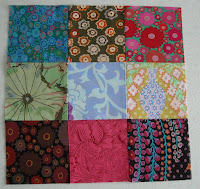Also, don't be afraid to mix in some other fabrics. I used a couple of flannel I Spy fabric squares in this quilt. Children like to feel the different textures of fabrics.
Even though I have been referring to diagonal rows, I did not construct this quilt in rows. I used the same 9-patch construction that I have used in previous blog posts of my quilts. There are nine 9-patch blocks in this quilt. That's 81 nickels (5" squares). It finishes at about 41"X41" which I think is a good size for a young child to drag around.
 |
| Nickel I Spy #2 |
I decided I wanted an allover quilting design for this quilt. Linda of L&R Designs used a pantograph quilting pattern called "Bubbles" and a variegated thread. I love the way it turned out! Here's a close-up-
For the back of the quilt, I used a fabric that I had purchased online to use in my I Spy quilts. When I received the fabric, I realized that the motifs were too big for nickel squares. That's one of the problems of ordering online. The next problem was that I had only ordered a yard and the quilt was 41"! Sooo, I pieced the backing. Here's what it looks like-
I was lucky enough to have two fabrics that I feel work well together. So the backing has plenty of things for kids to spy with their little eye and I used up some of my fabric stash instead of buying more. Well, at least I didn't buy any more for this quilt.























